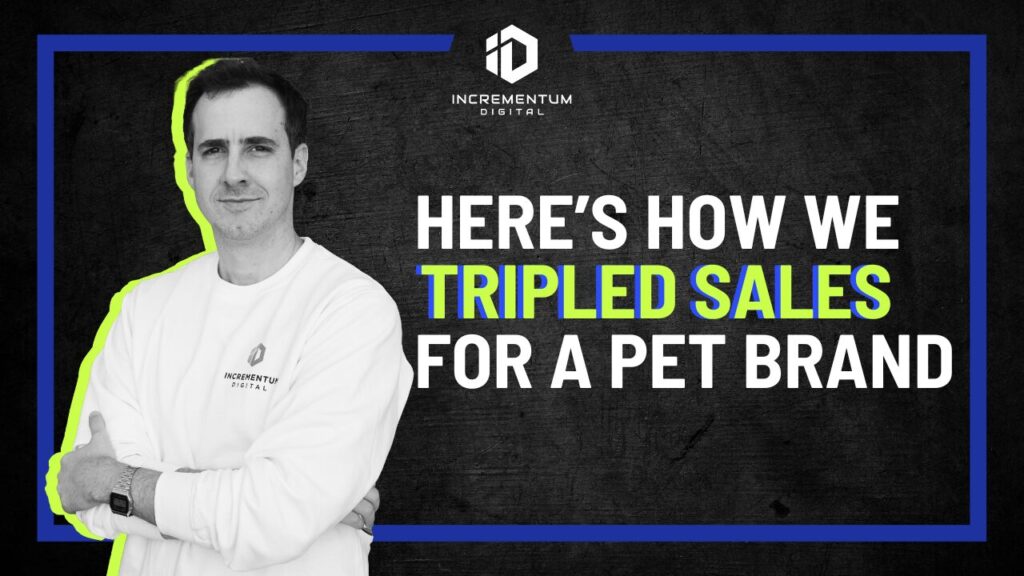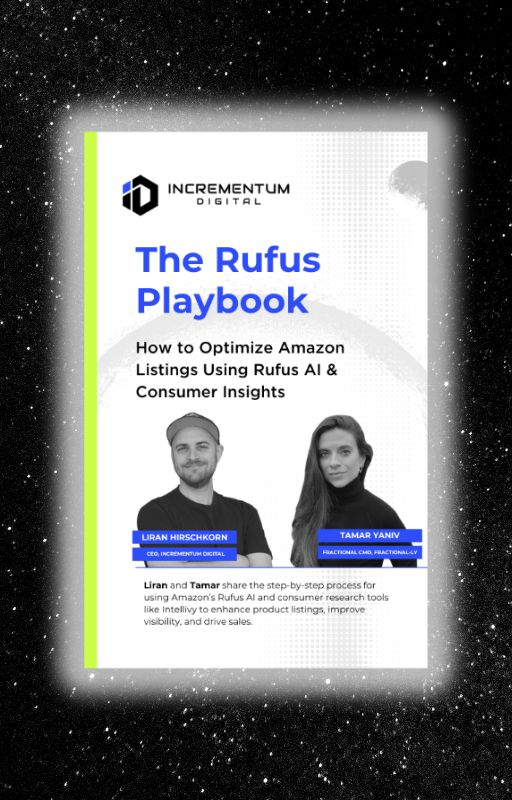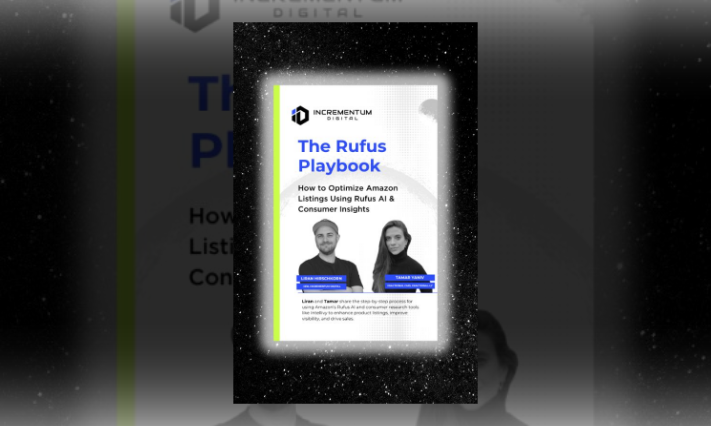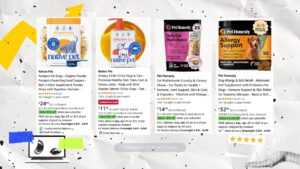Amazon Advertising
7 Strategies to Maximize Amazon Pet Day 2025: Learn How We Helped a Pet Treats Brand Triple Sales

The pet treats category on Amazon is crowded, competitive, and unforgiving. Brands like Purina, Pedigree, and Royal Canin dominate search results, and price pressure is relentless. In 2023, U.S. pet market sales hit over $143 billion, with pet food and treats making up the largest share, proof that demand is massive, but so is the competition.

Learn How to Make Listings That Convert in 2025!
Read our step-by-step guide on how to optimize your listings using Rufus AI insights. Sign up for our newsletter and get your copy for free!
Show me howDespite this challenge, our team helped this brand triple revenue without relying on event-driven spikes. Their growth came from durable, strategic execution.
Now, with Amazon Pet Day 2025 happening in mid-May, the stakes are even higher. If you’re selling in the pet category, you’ll want to consider applying the same tactics directly to the 48-hour window when high-intent shoppers flood the platform.
But first, what is Amazon Pet Day 2025?
Amazon Pet Day 2025 is a 48-hour event happening May 13–14, designed to flood the platform with thousands of deals across pet food, treats, toys, grooming supplies, and more. It’s Amazon’s fourth year running the event, and it’s only getting bigger.
The great thing about Pet Day shoppers is they aren’t just buying out of necessity; they’re browsing with emotion and intent. They’re restocking favorites, upgrading essentials, and splurging on their pets. That’s the perfect storm of high traffic, high intent, and a low barrier to trial.
Early deals begin April 29, which means your window to build visibility, capture attention, and structure your campaigns for scale starts now. What happens before May 13 is what determines if you’re buried—or breaking through—when the event goes live.
Our Client’s Challenge: Standing Out in a Crowded, Competitive Space
Our client came to us generating $190K per month, but couldn’t scale further without sacrificing efficiency. Their goal was clear: increase revenue, improve visibility across key search terms, and keep TACoS below 23 percent. Clearly, what they needed was a campaign structure that could hold up when the competition was at its peak.
So our team focused on building that structure. The goal was to create advantages across targeting, bidding, and retargeting while maintaining full control over performance. The strategy wasn’t built for a single event but to scale profitably year-round. But it’s exactly the kind of structure that prepares a brand to capitalize on high-volume events like Amazon Pet Day without scrambling to catch up.
Here’s how we structured their ad strategy to scale efficiently and convert at volume, starting with how we took control of keyword performance:
Strategy 1: Drive High-Intent Traffic with Keyword Isolation
Our team began by isolating high-relevance keywords into individual exact match campaigns. This allowed us to manage bids with precision, control spend by term, and remove noise from broader targeting approaches. To monitor performance, we built a weekly Search Term Impression Share (STIS) report. This report tracked how often our ads appeared relative to competitors and helped us quickly identify shifts in volume, click-through rate, and conversion rate at the keyword level.
For events like Amazon Pet Day, this level of control becomes even more valuable. Focus on keywords tied to gifting behavior, promotions, and large pack sizes. These terms tend to convert at higher rates and drive larger basket sizes during the event.
Strategy 2: Use Low-Bid Campaigns to Discover What Converts Before Pet Day
Before scaling spend, we launched auto and category targeting campaigns designed purely for discovery. The goal was to uncover high-performing search terms and ASIN targets we weren’t already bidding on directly. This early data gave us a clearer picture of where the brand had natural relevance and which competitor listings were worth targeting. It also surfaced unexpected long-tail queries that performed well with minimal competition.
By identifying these patterns in advance, we adjusted bids and scaled high-performing terms effectively.
The same discovery approach can guide pre-event planning for Pet Day. Thus, we recommend starting this process early. Run low-bid harvesting campaigns now to collect data ahead of April 29, when early deals begin and shopper behavior starts to shift. The insights you gather now will shape how effectively you can scale during the core 48-hour window.
Strategy 3: Use Pet Day to Scale Larger Pack Sizes and Bundles
High-priced SKUs often face slower velocity under normal conditions, but during high-traffic events like Amazon Pet Day, shopper behavior shifts. Customers are more willing to stock up, try premium formats, or upgrade to bundles, particularly when there’s a perceived deal.
We set up dynamic campaigns specifically for our client’s larger bag sizes and higher-priced variants. By running low-bid auto and broad match campaigns in the lead-up, we tested demand patterns without overspending. These SKUs performed strongest when price incentives were active, even outside major events.
During events like Pet Day, these types of offers are even more likely to drive volume. You can also consider bundling treats with grooming or dental care products to increase basket size and attach rate. Use price breaks or coupons to reinforce value, and make sure your creatives highlight the size or added benefit clearly. This is the moment to push volume, not just visibility.
Strategy 4: Increase Branded Impact with Sponsored Brand Video
We used Sponsored Brand Video (SBV) to secure premium placement on both branded and category-level search results. These ads were critical in reinforcing the brand’s presence when high-intent shoppers were in the decision phase and actively comparing products.
For branded terms, SBV helped capture traffic from returning or loyal customers while improving conversion rates. For product targeting, we placed videos on top-performing ASINs, giving us a second chance to influence purchase decisions directly on competitor listings.
We also used SBV to strategically upsell larger pack sizes and cross-sell complementary treats. Creative focused on value, health benefits, and the brand’s sustainability story to build trust quickly.
While this wasn’t executed during Pet Day, the same SBV structure can be themed and applied effectively for event-driven traffic. Highlight limited-time deals, showcase bundle value, and make sure your messaging aligns with the Pet Day mindset: practical value with a feel-good reason to buy.
Strategy 5: Retarget High-Intent Audiences with Sponsored Display
Using Sponsored Display (SD), we focused on audiences who had already shown interest but hadn’t completed a purchase. This included shoppers who viewed a product but didn’t convert, added items to their cart and abandoned checkout, or hadn’t repurchased in a while.
These segments came directly from behavior patterns we monitored during the campaign. For this pet treats brand, we saw strong results by re-engaging cart abandoners and previous buyers who hadn’t reordered within 30 days. The SD campaigns helped keep the brand top of mind and created low-friction touchpoints that pushed shoppers back into the funnel.
We also used SD alongside DSP to segment audiences based on intent and tailor messaging accordingly. This layered approach was simple to execute but made a measurable impact on conversion rates, especially when timed around deal periods.
For Amazon Pet Day, activate these Sponsored Display campaigns ahead of April 29 to start building retargeting pools. When traffic spikes during the event, you’ll already be positioned to convert the audiences most likely to buy.
Strategy 6: Use AMC Insights to Improve Timing and Sequence
Amazon Marketing Cloud (AMC) gave us the visibility needed to understand how shoppers moved through the funnel. For this pet treats brand, the data showed a clear trend: branded search volume spiked after off-Amazon awareness efforts like social media collaborations and influencer partnerships.
We also found that conversion rates increased significantly for shoppers who had been exposed to three or more ads within a two-week window. That insight shaped how we sequenced our campaigns: spend earlier to drive awareness, then follow up with Sponsored Display and DSP to close.
This type of sequencing is especially useful during high-traffic events like Pet Day, but it delivered results even without a tentpole event in this case. With so many competing messages, timing and repetition made the difference between getting ignored and getting clicked.
For Amazon Pet Day, align your off-Amazon channels with your media strategy. Run influencer content, email drops, or social campaigns in the week leading up to the event. When shoppers search on Amazon, your brand will already be in their heads, and your ads will finish the job.
Strategy 7: Convert with Precision Using Amazon DSP
To capture the full value of event-driven traffic, we used Amazon DSP to re-engage high-intent audiences with tailored messaging. This included visitors who viewed product detail pages but didn’t purchase, past buyers who hadn’t reordered, and shoppers who had recently purchased competitor products.
We built audience segments based on behavior, not guesswork. Then we deployed custom creative that spoke directly to each group, whether it was highlighting larger pack sizes, reinforcing brand values, or showcasing health benefits. The timing was just as important as the targeting. We timed DSP delivery during periods of peak intent. A similar approach works well for Pet Day traffic.
This approach closed the loop on all the awareness and engagement built earlier in the funnel. For this pet treats brand, it delivered high returns on spend by capturing audiences who already knew the product and just needed the right push.
For Amazon Pet Day, DSP is your opportunity to turn abandoned carts into revenue and turn one-time interest into long-term customer value. Use it to push bundles, upsell larger variants, and stay in front of shoppers who already showed intent.
Turn Amazon Pet Day into a Platform for Long-Term Growth
For this pet treats brand, what started as a tactical advertising overhaul became a system for sustained, profitable growth. If you’re preparing for Amazon Pet Day, this is the kind of structure that lets you scale with confidence. It’s your chance to introduce your brand to new customers, drive volume through high-converting SKUs, and build long-term loyalty through Subscribe & Save and repeat purchase behavior.
Best of all, these strategies we shared are replicable, targeted, and built for scale. If you want to apply this approach to your own brand, we’ll show you how.
Want a personalized growth plan based on your product catalog and goals?
Book a free audit today.
LET’S DISCOVER WHAT’S POSSIBLE FOR YOUR BRAND
We’re here to listen and uncover opportunities tailored to your unique goals.
Fill out the form to get started, and you’ll walk away with real insights and actionable recommendations—whether we work together or not.
- HANDS-ON LEADERSHIP
- AWARD-WINNING PARTNERSHIPS
- CUSTOM-BUILT SOLUTIONS




